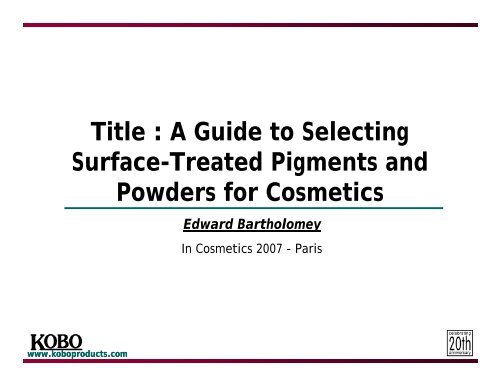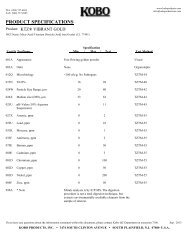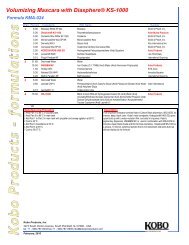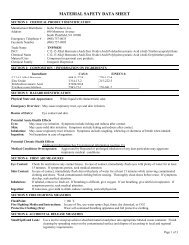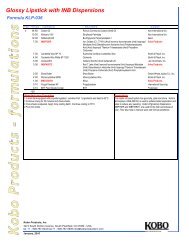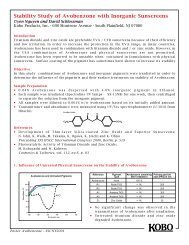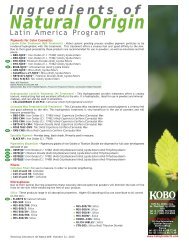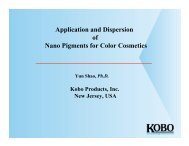A Guide to Selecting Surface-Treated Pigments and Powders for ...
A Guide to Selecting Surface-Treated Pigments and Powders for ...
A Guide to Selecting Surface-Treated Pigments and Powders for ...
You also want an ePaper? Increase the reach of your titles
YUMPU automatically turns print PDFs into web optimized ePapers that Google loves.
Title : A <strong>Guide</strong> <strong>to</strong> <strong>Selecting</strong><strong>Surface</strong>-<strong>Treated</strong> <strong>Pigments</strong> <strong>and</strong><strong>Powders</strong> <strong>for</strong> CosmeticsEdward BartholomeyIn Cosmetics 2007 - Pariswww.koboproducts.com
A <strong>Guide</strong> <strong>to</strong> <strong>Selecting</strong> <strong>Surface</strong>-<strong>Treated</strong> <strong>Pigments</strong> <strong>and</strong> <strong>Powders</strong> <strong>for</strong>Cosmetic Products• Presentation Objective:• To present some aids in assisting <strong>and</strong> assessing betterselection of surface treatments <strong>for</strong> cosmetic products.• Visual diagrams <strong>and</strong> data are used <strong>to</strong> aid selection,diagram, although it is recognized that the final decisionwill be influenced by per<strong>for</strong>mance, processing <strong>and</strong> cost, aswell as the technical <strong>and</strong> patent issues.• Help <strong>to</strong> reduce the number of variables <strong>and</strong> options thatexist in <strong>for</strong>mulating with surface treated powders <strong>and</strong>pigments.www.koboproducts.com
A <strong>Guide</strong> <strong>to</strong> <strong>Selecting</strong> <strong>Surface</strong>-<strong>Treated</strong> <strong>Pigments</strong> <strong>and</strong> <strong>Powders</strong> <strong>for</strong>Cosmetic Products• <strong>Surface</strong> treatments can enhance the surface of a material altering itsphysical <strong>and</strong> chemical properties. Stronger bonding with the matrixenhances mechanical properties, reduces shrinkage, increases stability,<strong>and</strong> lessens or eliminates surface or internal defects. Permits higherfiller loadings; improves dispersion; <strong>and</strong> improves powder flowcharacteristics, as well as flow during mixing.• The improved powder or pigment can be used <strong>for</strong> creating new product<strong>for</strong>ms, enhancing daily wear, assisting the application on the skin <strong>and</strong>optimizing the beauty fac<strong>to</strong>r by improving texture.• Overall per<strong>for</strong>mance is a composite of a number of fac<strong>to</strong>rs:1. Physical <strong>and</strong> chemical properties of the treatment.2. Integrity of the bonding between the treatment <strong>and</strong>substrate.3. Degree of completeness <strong>and</strong> coverage of the coating.4. Potential of the substrate <strong>for</strong> surface-treatment.www.koboproducts.com
A <strong>Guide</strong> <strong>to</strong> <strong>Selecting</strong> <strong>Surface</strong>-<strong>Treated</strong> <strong>Pigments</strong> <strong>and</strong> <strong>Powders</strong> <strong>for</strong>Cosmetic Products• Loading level on the filler surface is a function of thesurface area of the filler.• While it was thought that one layer should be sufficient,experimentation has shown that several layers can provideoptimal results in some cases.• Typical fillers with average particle sizes of 1 <strong>to</strong> 5 micronsoften give best results when treated with about 1 percent(<strong>for</strong> silane).www.koboproducts.com
A <strong>Guide</strong> <strong>to</strong> <strong>Selecting</strong> <strong>Surface</strong>-<strong>Treated</strong> <strong>Pigments</strong> <strong>and</strong> <strong>Powders</strong> <strong>for</strong>Cosmetic Products• The potential of the substrate <strong>for</strong> surface treatment may vary.• Silicates, hydroxides, inorganic metal oxides possess hydroxyl groups <strong>for</strong> reaction.www.koboproducts.com
A <strong>Guide</strong> <strong>to</strong> <strong>Selecting</strong> <strong>Surface</strong>-<strong>Treated</strong> <strong>Pigments</strong> <strong>and</strong> <strong>Powders</strong> <strong>for</strong>Cosmetic ProductsIron Oxide, Mica or otherswww.koboproducts.com
How do I select the optimal surface treatment <strong>for</strong> my product?www.koboproducts.com
A <strong>Guide</strong> <strong>to</strong> <strong>Selecting</strong> <strong>Surface</strong>-<strong>Treated</strong> <strong>Pigments</strong> <strong>and</strong> <strong>Powders</strong> <strong>for</strong>Cosmetic Products• General Selection:• The choice of which surface treatment <strong>to</strong> use in a particular applicationis determined by the nature of the benefit that is <strong>to</strong> be derived from thetreatment.• If the treatment is designed <strong>to</strong> provide surface hydrophobicity, then atreatment with a hydrophobic group, such as caprylyl, fluorocarbon orphenyl should be chosen.• If the silane treatment is designed <strong>to</strong> provide compatibility of themineral in a polymer matrix, then the nature of the organic group on thesilane should be similar <strong>to</strong> the chemical structure of the polymer (i.e., acaprylyl or longer chain alkyl group will help provide compatibility <strong>and</strong>dispersibility of the substrate in the medium.www.koboproducts.com
A <strong>Guide</strong> <strong>to</strong> <strong>Selecting</strong> <strong>Surface</strong>-<strong>Treated</strong> <strong>Pigments</strong> <strong>and</strong> <strong>Powders</strong> inCosmetic ProductsProduct Form <strong>and</strong> Base Formulation are Key Drivers<strong>for</strong> <strong>Surface</strong> Treatment SelectionFormulation/Processing Fac<strong>to</strong>rs <strong>for</strong> Consideration when <strong>Selecting</strong> <strong>Surface</strong> Treatments:www.koboproducts.com
A <strong>Guide</strong> <strong>to</strong> <strong>Selecting</strong> <strong>Surface</strong>-<strong>Treated</strong> <strong>Pigments</strong> <strong>and</strong> <strong>Powders</strong> <strong>for</strong>Cosmetic ProductsTitanium DioxideMT-100SMT-100TMT-100TVMT-100ZMT-100FMT-150WMT-100SAMT-100SASSMT-100SASMT-500BMT-500HMT-500SAMT-500HDMT-500SASSMT-500SASMT-600BMT-600SAMT-700HDParticleSize(nm)151515151515151515353535303535505050Specific<strong>Surface</strong>Area(m2/g)50-7050-7050-7040-6050-7080-11080-11050-8050-8030-5030-5030-5040-6025-4525-4525-3540-6040-60www.koboproducts.com
A <strong>Guide</strong> <strong>to</strong> <strong>Selecting</strong> <strong>Surface</strong>-<strong>Treated</strong> <strong>Pigments</strong> <strong>and</strong> <strong>Powders</strong> <strong>for</strong>Cosmetic ProductsTechnical/Physical testing of comparative treatmentsWithin this evaluation of a few properties, Silane appears <strong>to</strong> have the bestcombination of properties.Technical testing can help <strong>to</strong> differentiate between multiple surface-treatments.The results would benefit from correlation with sensory data <strong>and</strong>/or consumer data.Graph constructed from original data by Jane Hollenbergwww.koboproducts.com
A <strong>Guide</strong> <strong>to</strong> <strong>Selecting</strong> <strong>Surface</strong>-<strong>Treated</strong> <strong>Pigments</strong> <strong>and</strong> <strong>Powders</strong> <strong>for</strong>Cosmetic ProductsGeneral:1General Approach <strong>for</strong> <strong>Selecting</strong> <strong>Surface</strong>-<strong>Treated</strong> Materials <strong>for</strong> a FormulationProjectDefine <strong>and</strong> design the initial pro<strong>to</strong>types <strong>for</strong>product <strong>for</strong>m or vehicle based upon theconcept <strong>and</strong> technical targets.2Gather technical literature <strong>and</strong> begin search <strong>for</strong> patentapplications <strong>and</strong> issued patents (past <strong>and</strong> present) <strong>to</strong>determine viability <strong>and</strong> considerations <strong>for</strong> the project.3Create technical <strong>and</strong> sensory tests, as wellas consumer testing plan <strong>to</strong> evaluate theper<strong>for</strong>mance of the product. Conductstability testing in parallel.<strong>Surface</strong> Treatment SelectionTierITier I - "High <strong>Surface</strong> Area Products"[ <strong>Surface</strong> Modification is a highly integral part of theproduct design.]; Delivers benefits that cannot beobtained without the use of treatments. Product is fullydependent upon the surface-treatment.]TierIITier II - "Moderate <strong>Surface</strong> Area Cosmetics"[<strong>Surface</strong> Modification is of moderate <strong>to</strong> high importance <strong>to</strong>the product.]; Provides significant improvements in one ormultiple areas, either via sensory attributes, stability or process/manufacturing.TierIIITier III - "Lower <strong>Surface</strong> Area Cosmetics"[<strong>Surface</strong> Modification is of a somewhat less <strong>to</strong> moderate consideration <strong>to</strong>the product.]; Provides measureable <strong>and</strong> marginally or significantly betterimprovements in one or multiple areas, either via sensory attributes, stability orprocess/manufacturing.(<strong>Surface</strong>-treated materials comprise 65 - 100% (%w/w) ofthe resultant cosmetic film on skin, or are nanoparticles at>10% that have a high surface area.On average with a 2% surface treatment, the amount of(<strong>Surface</strong>-treated pigments/powders comprise 10 <strong>to</strong>
A <strong>Guide</strong> <strong>to</strong> <strong>Selecting</strong> <strong>Surface</strong>-<strong>Treated</strong> <strong>Pigments</strong> <strong>and</strong> <strong>Powders</strong> <strong>for</strong>Cosmetic ProductsTechnical Descriptions of Product Form <strong>for</strong> each TierTechnical Description <strong>for</strong> Tier I ProductsPro<strong>to</strong>type <strong>for</strong>mulation is either a :1. Powder-type product (neat or with binder)2. Or is a product <strong>for</strong>m that contains a high concentration ofvolatile liquids; may also contain a small amount of non-volatileliquids/waxes.3. Or is a sunscreen product that contains >10% of micronizedtitanium dioxide or other particles considered <strong>to</strong> be nanoparticlesthat occupy a large volume of the resultant film on the skin.4. A dry or slightly moist powder film is deposited <strong>and</strong> remains onthe skin after evaporation of volatiles, if present.Technical Description <strong>for</strong> Tier II ProductsPro<strong>to</strong>type <strong>for</strong>mulation is either a :1. Powder or Creme type product containing a moderate amount ofnon-volatile liquids/waxes.2. Or is a product <strong>for</strong>m containing a mixture of a moderateconcentration of volatile <strong>and</strong> non-volatile liquids/waxes.3. A somewhat moist powder film is deposited <strong>and</strong> remains on theskin after evaporation of volatiles, if present.Technical Description <strong>for</strong> Tier III ProductsPro<strong>to</strong>type <strong>for</strong>mulation is either a :1. Powder or Creme type product containing a high amount of non-volatile liquids2. Or is a product <strong>for</strong>m containing a mixture of a high concentration of volatile <strong>and</strong>non-volatile liquids/waxes.3. A moist powder film is deposited <strong>and</strong> remains on the skin after evaporation ofvolatiles, if present.Tier I Tier II Tier IIIExamples of Product Type <strong>for</strong> each TierExamples of Tier I Products:Pressed Face <strong>Powders</strong> <strong>and</strong> Eyeshadows, Water-in-VolatileSilicone Emulsion Foundation Make-Ups, Volatile Silicone-in-Water Emulsions (Shine Control Products), Anhydrous VolatileCreme Blushers, Mascara Gels or Emulsions <strong>and</strong> Trans<strong>for</strong>mationalProducts - (Creme-<strong>to</strong>-Powder) <strong>and</strong> (Volatile Stick Products;Foundations, Antiperspirants); High SPF Inorganic SunscreensExamples of Tier II Products:Oil-in-Water, Water-in-Oil or Silicone Emulsions (Inorganic-BasedSunscreens <strong>and</strong> Foundation Make-Up), Anhydrous Semi-VolatileCreme Eyeshadows, Concealers; Semi-Volatile Sticks (Lipsticks,Foundations or Antiperspirants)Examples of Tier III Products:Water-in-Oil Emulsions (Facial Care, Moisturizers with Microspheres/SoftFocus, Color Accentua<strong>to</strong>rs, Sunscreens), Anhydrous Non-Volatile Cremes/Gels (Blushers), Non-Volatile Sticks (Sunscreens, Lipsticks, Foundations orAntiperspirants)Tier I Tier II Tier IIIwww.koboproducts.com
A <strong>Guide</strong> <strong>to</strong> <strong>Selecting</strong> <strong>Surface</strong>-<strong>Treated</strong> <strong>Pigments</strong> <strong>and</strong> <strong>Powders</strong> <strong>for</strong>Cosmetic Products<strong>Selecting</strong> <strong>Surface</strong> Treatments <strong>for</strong> each TierTier I - "Use Core <strong>Surface</strong> Treatments"Focus on single, individual <strong>Surface</strong> Treatments. Select surfacetreatment most closely matched <strong>to</strong> target attributes <strong>and</strong> thensecondly <strong>to</strong> compatibility of system These treatments when usedin Tier I systems provide distinct properties in these types ofsystems. They provide the most direct contact with the skin orlashes/hair when used in this manner.Some Preferred treatments are:[MS] (Methicone)[ITT] (Isopropyl Titanium Triisostearate)[11S2] (Triethoxy Caprylylsilane)[MM] (Magnesium Myristate)[PF] (C9-15 Fluoroalcohol Phosphates)Tier II - "Use Hybridized <strong>Surface</strong> Treatments"Focus on hybrid <strong>Surface</strong> Treatments that provide a blend ofmatching targeted attributes <strong>and</strong> compatibility. They should bematched <strong>to</strong> the solvents/polarity <strong>and</strong> give the desired properties inthese types of systems. They provide good contact with the skin orlashes/hair.Some Preferred treatments are:TTB ( Isopropyl Titanium Triisostearate/DimethiconeCrosspolymerTTS ( Isopropyl Titanium Triisostearate/ TriethoxycaprylylsilaneCrosspolymer)TTM ( Isopropyl Titanium Triisostearate/MethiconeCrosspolymer)FSA (C9-15 Fluoroalcohol Phosphates (<strong>and</strong>) Acrylates/DimethiconeCopolymer)FOTS (C9-15 Fluoroalcohol Phosphates (<strong>and</strong>) TriethoxyCaprylylsilane)ASC (Acrylates/Dimethicone Copolymer)Tier III - "Use Full Range of Treatments"Focus on any <strong>Surface</strong> Treatment that provides the best compatibility <strong>and</strong>stability, may include higher concentrations of surface treatments (>5 or10%). They should be matched <strong>to</strong> the solvents/polarity <strong>and</strong> give the desiredproperties in these types of systems. These systems provide less directcontact with the skin or lashes/hair when the absorption is slow.Some Preferred treatments are:[ITT] (Isopropyl Titanium Triisostearate)[11S2] (Triethoxy Caprylylsilane)TTS ( Isopropyl Titanium Triisostearate/ TriethoxycaprylylsilaneCrosspolymer)TTM ( Isopropyl Titanium Triisostearate/Methicone Crosspolymer)ASC (Acrylates/Dimethicone Copolymer)FSA (C9-15 Fluoroalcohol Phosphates (<strong>and</strong>) Acrylates/DimethiconeCopolymer)BAS2 Triethoxysilylethyl Polydimethylsiloxyethyl Hexyl Dimethicone[LL] (Lauoryl Lysine)Tier I Tier II Tier IIIwww.koboproducts.com
A <strong>Guide</strong> <strong>to</strong> <strong>Selecting</strong> <strong>Surface</strong>-<strong>Treated</strong> <strong>Pigments</strong> <strong>and</strong> <strong>Powders</strong> <strong>for</strong>Cosmetic Products• Summary:• <strong>Surface</strong> treatments can be pre-determined <strong>and</strong> selectedearlier in the development process by better defining theproduct <strong>for</strong>m <strong>and</strong> placing some limitations on thecomposition.• Technical testing can help <strong>to</strong> guide the selection.• Creating a greater distinction between individual (single),hybridized <strong>and</strong> also cus<strong>to</strong>mized surface-treatments canenhance the underst<strong>and</strong>ing of the selection process.www.koboproducts.com
A <strong>Guide</strong> <strong>to</strong> <strong>Selecting</strong> <strong>Surface</strong>-<strong>Treated</strong> <strong>Pigments</strong> <strong>and</strong> <strong>Powders</strong> <strong>for</strong>Cosmetic Products• Special thanks <strong>to</strong> Jane Hollenberg <strong>and</strong> David Dick from Gelest• And David Schlossman <strong>and</strong> Yun Shao from Kobo Products, Inc.www.koboproducts.com


